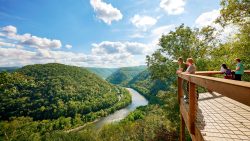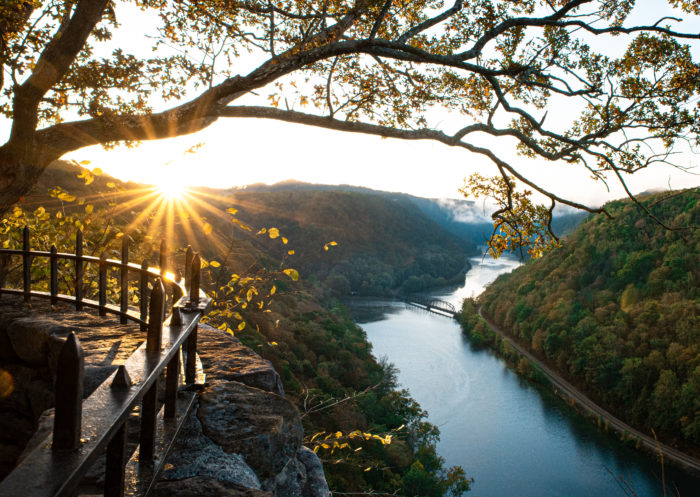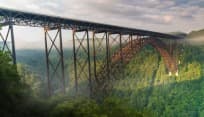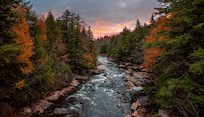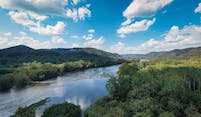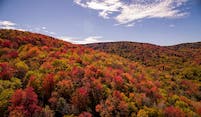5 crazy plants you won’t believe grow here
As the days get warmer, West Virginia bursts into bloom with a variety of unique plant life.
Check out some Bleeding Hearts at Dolly Sods or get a glimpse of the ghostly “corpse plant” at Grandview.
Make a checklist and hit the forest for a different kind of scavenger hunt, and take photos of each unique bloom you find.*
Here’s what to look for:
1. See wild diversity in the NRG
The New River Gorge’s unique topography and northern flowing river make it one of the most “relatively unfragmented, mid-latitude forests in the world.” With more than 72,000 acres of protected land, the gorge sprouts some pretty unique plantlife.
The start of spring is signalled by the arrival of foul-smelling skunk cabbage, which creates its own heat that allows it to burst out and bloom, even when the ground is still frozen.
Be sure to take a walk at Wildflower Weekend, where you’ll get a chance to explore the area’s diversity with professional guidance. You can find similar programs at Babcock State Park, Hawks Nest State Park, Little Beaver State Park, Pipestem Resort State Park and Tamarack.
2. Search for rare gems at Grandview State Park
You won’t want to miss the vibrant sea of pink and purple blooms at Grandview State Park, which is known for its towering Rhododendron bushes.
Later in summer, come back in search of the Indian Pipe, a ghostly white plant form that doesn’t have chlorophyll (that’s the stuff that gives plants their green coloring.) Also known as “corpse plant,” it goes black as it ages.
3. Catch a glimpse of Bleeding Hearts at Dolly Sods
Dolly Sods, a high-elevation plain on the Allegheny Plateau, is an anomaly. The plant life and climate resemble northern Canada, and many species here are near their southernmost point. Some examples of this phenomenon are the Balsam Fir, Chamomile Grapefern, Bartram’s Serviceberry and Star Violet.
An always unique sight atop the sods are one-sided red spruce banner trees. Strong westerly winds dehydrate one side of the trees so that only branches on the other side grow. These trees are usually wider at the base than they are tall.
If you’re lucky, you might get a peek at some wild Bleeding Hearts, too.
4. Don’t get too close to the carnivorous plants at Cranberry Glades
Cranberry Glades is an extremely fragile wetland ecosystem that supports more than 60 unique plant species, many of which grew from seeds that took root more than 10,000 years ago. Like Dolly Sods, the glades seem a little out of place, with a landscape more like Canada.
Come to the glades to get a rare glimpse at carnivorous, insect eating plants, like Pitcher’s Plant and Sundew.
Also keep your eyes peeled for Bishop’s Cap, Jewelweed, False Hellebore, Indian Pipe, Turtlehead, Wild Raisin and Grass Pink Orchid.
While you’re exploring, please use the half-mile boardwalk so the fragile plant life will be there for future visitors!
5. Head to the hills in search of an Appalachian delicacy
Every spring, eager ramp-diggers head to the self-proclaimed Ramp Capital of the World: Richwood. Ramps are a wild onion, kind of similar to a scallion. And boy, are they coveted in the Mountain State.
In late March or early April, they reach about 8 to 10 inches— prime pickin’ time. They’ve got to be carefully dug from the damp earth with roots intact, to keep the growth of next year’s crop in mind.
If diggin’ in the soil isn’t your definition of a good time, head to Richwood’s Feast of the Ramson, where you can get a taste of the delicacy without getting your hands dirty.
Richwood’s definitely not the only place to find— or taste— these pungent plants. You can uncover wild ramps across the state, and join in on community ramp feasts in dozens of small towns all over West Virginia, too. (Our Best of Spring map can lead you to a few wild-foraged favorites.)
How many of these unique plants have you seen?
*Remember that removing plants is illegal in most places. Leave the beauty for others to enjoy. Most rare plants die after being removed from their original habitat. A photo lasts forever.
This post was last updated on July 22, 2020

